

(Available on the first of each month to Tile Heritage members who e-mail the Foundation from the address they
would like
E-News sent to. Contact: foundation@tileheritage.org)
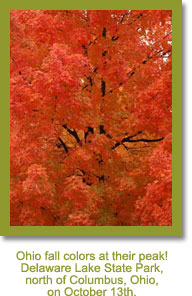
Ohio at the Peak
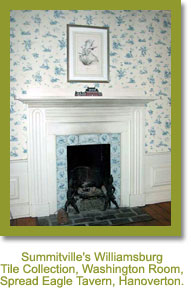
In mid-October Sheila Menzies and Joe Taylor visited Ohio, specifically responding to an invitation from David Johnson at Summitville Tiles. The company had decided to close its Art Department; and along with the Museum of Ceramics and the Ohio Historical Society, Tile Heritage was invited to review the historic documents, product samples, artwork and other memorabilia for possible inclusion in the Tile Heritage library and archives.
We arrived in crisp, sunny weather with foliage colors at their peak. Summitville lies south of Youngstown in rolling landscape not far from the Ohio River and the West Virginia border. As well as owning Summitville Tiles, the Johnson family runs an impeccably restored early 19th century hostelry called the Spread Eagle Tavern and Inn located in nearby Hanoverton. We had the good fortune to be hosted there in grand style, staying in the Washington Room, complete with not one, but two fireplaces with period style tiles from Summitville's Williamsburg Tile Collection. The inn was like a museum from rathskeller to rooftop and served delicious food and wine to boot! See www.spreadeagletavern.com.
 Our visit to the Art Department at Summitville Tiles was most interesting.
Although saddened that such a treasure needed to be dismantled, we were
encouraged that the future of all of these materials had been provided for.
Our visit to the Art Department at Summitville Tiles was most interesting.
Although saddened that such a treasure needed to be dismantled, we were
encouraged that the future of all of these materials had been provided for.
 David Johnson left us to explore the contents,
inviting us to tag materials
that we felt would be important to retain for the Tile Heritage archives. In
the near future, these materials will be sent to Tile Heritage for
safekeeping. We are most appreciative of the donation of these historic
documents, drawings, catalogs and tiles. In production for nearly a hundred
years as a brick and tile manufacturer, Summitville has served as a "golden
spike" in American industry. Visit www.summitville.com.
David Johnson left us to explore the contents,
inviting us to tag materials
that we felt would be important to retain for the Tile Heritage archives. In
the near future, these materials will be sent to Tile Heritage for
safekeeping. We are most appreciative of the donation of these historic
documents, drawings, catalogs and tiles. In production for nearly a hundred
years as a brick and tile manufacturer, Summitville has served as a "golden
spike" in American industry. Visit www.summitville.com.
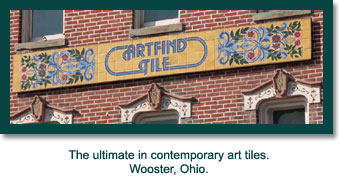
Tile Art Found in Wooster
Arriving unannounced, we knocked on the door of Artfind Tile in Wooster, a prosperous mini-metropolis due west of Summitville. With luck, we found the proprietors at home. Brigid O'Connor, the more stationary of the pair, and Eric Astrachan, who as executive director of the Tile Council of North America is continually on the go, were as surprised to see us as we were to find them! And immediately the "10 minute," turned 4 hour(!), tour began.
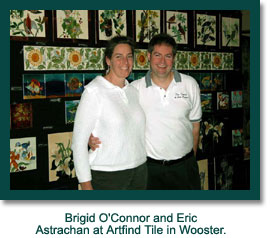
The Artfind studio and showroom of handcrafted art tiles from all over the U.S. was impressive enough, and perhaps the tour should have ended there. But, beware, no tour at Artfind is complete without visiting all floors, including the basement and the roof, and hearing all the stories associated with the reconstruction of this marvelous 1881 building.

We had the privilege of visiting the Cornerstone Elementary School, a classic example of Tudor Revival architecture that was saved from demolition in the mid-1990s by an inspired and informed citizenry. And then to the natatorium at the new Wooster High School where in 1994 Artfind Tile produced and donated a series of extraordinary murals, "At the Water's Edge," that adorn the interior wall above the pool.

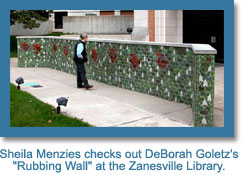
Zanesville: Where Tiles Were First Manufactured
We could not visit Ohio without a visit with tile historian Mike Sims and
his wife Alta in Zanesville, where tiles were first manufactured in the U.S.
They graciously hosted us at their home for a fine meal and lots of tile
"show and tell." Mike is an avid collector of encaustic tiles and has
lectured at THF symposiums and written numerous articles for both "Flash
Point"
and Tile Heritage.
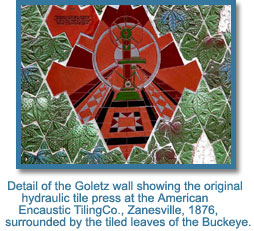 We were encouraged by Mike and Alta to visit a couple of contemporary
installations in Zanesville before we departed. The first was a remarkable
installation at the public library, an interactive work by DeBorah Goletz.
We were encouraged by Mike and Alta to visit a couple of contemporary
installations in Zanesville before we departed. The first was a remarkable
installation at the public library, an interactive work by DeBorah Goletz.
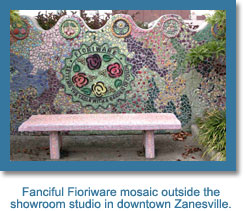 All of the tile panels represent the history of the city and are designed to
be used to make rubbings, using paper and wax crayon.
All of the tile panels represent the history of the city and are designed to
be used to make rubbings, using paper and wax crayon.
Running between rain showers we found the second installation at the Fioriware Studio and showroom downtown. The exterior and parking perimeter is delightfully decorated with lush, fanciful mosaic, much of it picassiette broken wares from the studio itself.
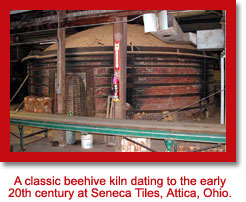
Seneca Tiles Visit
The fourth day of our Ohio tile tour took us from Zanesville west around
Columbus and then due north. We drove through small towns and rain softened
cornfields,
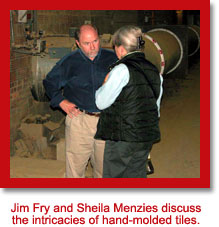 richly colored landscapes under a vast open sky, eventually
stopping at Seneca Tiles outside the town of Attica about 40 miles south of
Lake Erie. Joe had visited the plant several times before and instinctively
knew where to turn off the highway on to County Road 23. There certainly was
no indication that nestled among the cornstalks was a vibrant tile factory
replete with beehive kilns.
richly colored landscapes under a vast open sky, eventually
stopping at Seneca Tiles outside the town of Attica about 40 miles south of
Lake Erie. Joe had visited the plant several times before and instinctively
knew where to turn off the highway on to County Road 23. There certainly was
no indication that nestled among the cornstalks was a vibrant tile factory
replete with beehive kilns.
Seneca Tiles has been in operation since 1978 and is owned by Jim Fry, a consummate ceramist and astute businessman. The factory with its beehive kilns has an earlier history as a plant for the production of clay, field-drainage tiles dating back to 1906.
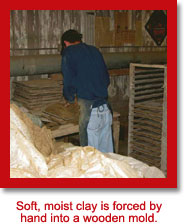 Throughout the plant tour, we remained intrigued as Jim described what
happens at Seneca as "generally abandoned techniques" are used for making
tiles: tilemakers hand-filling wooden
Throughout the plant tour, we remained intrigued as Jim described what
happens at Seneca as "generally abandoned techniques" are used for making
tiles: tilemakers hand-filling wooden
 molds with heaps of puffy, moist clay,
scraping them off, then emptying them immediately and setting the tiles up
to dry, just as it's been done for hundreds of years.
molds with heaps of puffy, moist clay,
scraping them off, then emptying them immediately and setting the tiles up
to dry, just as it's been done for hundreds of years.
Seneca also makes unglazed quarry pavers in a variety of shapes and shades. These have a beautiful flash finish that comes from an unhurried firing in a beehive kiln. The rest of Seneca's production includes hundreds of different shapes and colors of glazed field tiles and hand-molded tiles. These unique and authentic American handcrafted products are distributed nationwide. We came away with a fine appreciation for this "feast of clay" amidst the cornfields of northern Ohio. Visit www.senecatiles.com.
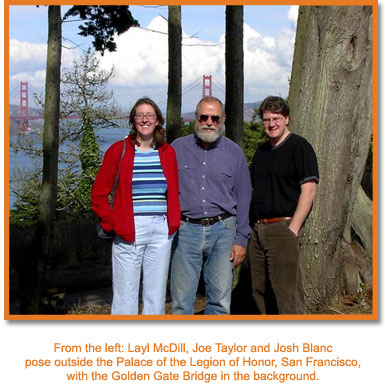
October Guests at Tile Heritage
Tile Heritage played host for a few days to visiting THF members, artists Josh Blanc and Layl McDill from Minneapolis. Josh is president of the Handmade Tile Association and was the main "mover and shaker" who assisted us in organizing the "Tiles in the Twin Cities" symposium in 2002. Together the two run Clay Squared to Infinity, where each has a studio and where the tiles of many other artists are sold. See www.claysquared.com.
While here on the West Coast, the couple enjoyed digging through the THF library when they weren't out scouring the countryside. They spent a night with THF board member Donna Billick at her studio in Davis, toured the pottery at Gladding McBean in Lincoln, as well as the State Capitol in Sacramento. Their final hours in San Francisco were spent touring tile installations in the Marina District, an area of the city that's been mapped by THF board member Riley Doty.
New Books ~ Perfect Holiday Gifts!
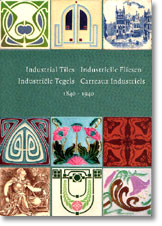
Industrial Tiles 1840-1940 is a superb catalog of an international traveling
exhibition that opened in Germany in August 2004 and will travel in the
coming year to Belgium, The Netherlands and England. Don't be put off by the
title! This is a marvelous and informative book in four languages written by
four preeminent tile scholars and edited by two others, including Hans van
Lemmen. The aim of the exhibition is to draw attention to the rich diversity
of industrial tiles made in England, Germany, Belgium, France and The
Netherlands. Although industrial tiles were mass-produced, they nevertheless
reveal a fascinating range of production techniques, styles, and subject
matter, becoming an important functional and decorative element in
nineteenth and twentieth century architecture. Fabulous tiles of the
Victorian and Edwardian eras are reproduced in this catalog, which should be
on the bookshelf of every tile enthusiast! Soft cover, 142 pages in full color.
Price approx. $20. ~ Email: buckland.books@tiscali.co.uk for a copy.
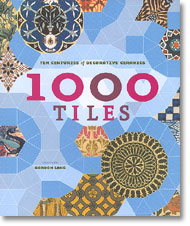
1000 Tiles: Ten Centuries of Decorative Ceramics, edited by Gordon Lang, is
touted as the "ultimate guide to tiles from across the globe and through
the centuries." Organized by period and type, this comprehensive compendium
features 1000 full-color images illustrating one thousand years of stylistic
evolution, each matched with an intriguing profile. Part One covers
Pre-Industrial: Islamic, Maiolica, Medieval and Dutch; Part Two,
Post-Industrial: Victorian, British Arts & Crafts, American Arts & Crafts,
and Art Nouveau; and Part Three, The Modern Age: Art Deco, Modernist and
Artist Tiles, and Contemporary. Also find a bibliography, glossary and
index. Soft cover, 320 pages, in full color.
Price: $29.95
(CA residents add 7.5% sales tax) plus $6 for shipping/handling.
This book is IN STOCK at Tile Heritage! Book Order Form